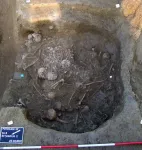(Press-News.org) Drug developed by Northwestern scientists
Fatal brain cancer has no current cure
Drug is revolutionary new class of drugs applicable to other neurological diseases
CHICAGO --- An early clinical trial in individuals with the deadly brain cancer, glioblastoma, showed an experimental spherical nucleic acid (SNA) drug developed by Northwestern University scientists was able to penetrate the blood-brain barrier and trigger the death of tumor cells.
This is the first time a nanotherapeutic has been shown to cross the blood-brain barrier when given through intravenous infusion and alter the genetic machinery of a tumor to cause cell death. The drug crossed the blood-brain barrier, dialed down the level of a cancer-causing gene and promoted tumor cell death.
The Northwestern Medicine study will be published March 10 in Science Translational Medicine. The results build upon previously published pre-clinical research by the Northwestern team.
"We showed the drug, NU-0129, even at very small doses, causes tumor cells to undergo what's called apoptosis or programmed cell death," said lead investigator Dr. Priya Kumthekar, an associate professor of neurology at Northwestern University Feinberg School of Medicine and a Northwestern Medicine physician. "It's a remarkable finding in humans that confirms what we had previously seen in our animal studies."
Now Northwestern scientists plan to use this technology to advance this type of therapeutic for brain tumor care.
The phase 0 study was conducted with eight individuals who had recurrent glioblastoma at the Robert H. Lurie Comprehensive Cancer Center of Northwestern University. In phase 0, investigators use a small dose of medication to make sure it isn't harmful to humans before they start using it in higher doses in larger clinical trials.
Study participants received the drug intravenously prior to surgery. Following tumor removal, Kumthekar and her team studied the tumors to determine how well the drug crossed the blood-brain barrier and its effect on the tumor cells.
Glioblastoma affects approximately 13,000 to 15,000 patients each year in the United States and is uniformly fatal. There have been no new drugs approved for glioblastoma in the past decade. Scientists said it's been hard to develop a drug that can breech the protective blood-brain barrier and reach the highly aggressive brain tumor.
SNAs look like a Koosh ball
"This unique 3D design has the ability to infiltrate tumor cells to correct the genes inside and make them susceptible for therapy-induced killing," said senior author Alexander Stegh, an associate professor of neurology at Northwestern.
NU-0129 is the first SNA drug developed for systemic use. SNAs are structures consisting of of DNA or RNA arranged around a nanoparticle, which looks like a Koosh ball, Stegh said.
Stegh developed the drug with Chad A. Mirkin, the discoverer and inventor of the SNA platform and the George B. Rathmann Professor of Chemistry at the Weinberg College of Arts and Sciences and director of Northwestern's International Institute for Nanotechnology.
The glioblastoma drug represents a revolutionary new class of drugs. The novel SNA platform on which it is based can be applied to other types of neurological diseases, such as Alzheimer's, Huntington's and Parkinson's, by similarly turning down the genes that lead to those diseases.
Highly unusual drug route
It's highly unusual for a drug to be developed in preclinical research at a university, shepherded through U.S. Food & Drug Administration approval as an investigational new drug and studied in a clinical trial -- all within the same university and without funding from a pharmaceutical company. In most cases, a drug is developed and licensed to a pharmaceutical company.
"We want to move the technology forward as quickly as possible because there are patients with a disease with no current cure," Kumthekar said.
Dr. Leon Platanias, director of the Lurie Cancer Center, said, "These exciting findings for the first time support the potential of spherical nucleic acids for drug delivery to brain tumors. They may prove to have important long-term translational implications for the treatment of these tumors."
INFORMATION:
Kumthekar and Stegh are members of the Lurie Cancer Center.
Other Northwestern authors include: Caroline H. Ko, Tatjana Paunesku, Karan Dixit, Adam M. Sonabend, Orin Bloch, Matthew Tate, Margaret Schwartz, Laura Zuckerman, Ray Lezon, Rimas V. Lukas, Borko Jovanovic, Kathleen McCortney, Serena Tommasini-Ghelfi, Lisa A. Hurley, Dusten Unruh, Nitya V. Sharma, Manoj Kandpal, Fotini M. Kouri, Ramana V. Davuluri, Daniel J. Brat, Ann K. Adams, C. David James, Gayle E. Woloschak and Craig Horbinski.
Stegh is shareholder of Exicure Inc., which develops SNA therapeutics. He and Caroline Ko are inventors on patent entitled "Nanoconjugates able to cross the blood-brain barrier." Rimas Lukas serves on the speakers' bureau for Novocure and has received honoraria for medical editing for EBSCO Publishing and Medlink Neurology, for creating and presenting CME board review material for American Physician Institute and Clinical Care Options, and for consulting from Abbvie, Eisai, NewLink Genetics and Reneuron. Lukas also has served on advisory boards for Monteris and Novocure. Margaret Schwartz has served on the advisory board and the speakers bureau for Novocure. Jeremy Heidel has been a paid consultant to Northwestern University for the NU-0129 project.
This research was supported by the Office of Research at Northwestern University, the Center for Cancer Nanotechnology Excellence Initiative of the National Institutes of Health (NIH) under award U54 CA151880 and 199091, the Northwestern brain tumor SPORE grant under the National Cancer Institute award P50CA221747, NIH grant S10OD020118, NIH ARRA grant SP0007167 and Department of Energy contract DE-AC02-06CH11357.
By analyzing more than a decade's worth of information on 55 crops, all dependent on pollinators, scientists have revealed that developed countries are particularly reliant on imported pollinator-dependent crops, while countries that export the majority of these crop types are major drivers of pollinator declines. Their assessment of the "virtual" exchange of pollinator services in the global food trade could help governments and agencies form new policies to preserve crop diversity and tackle biodiversity loss. In today's globalized world, human food consumption largely depends on the trade of crops and the intense use of resources such as water and land. Pollinators such as bees, ...
OSAKA, Japan - The hippocampus is the part of the brain that deals with information associated with spatial navigation and memory. For example, you are driving and despite the changing environment of different cars going at varying speeds, on and off ramps, distracting billboards, etc., you adjust your speed, glance only momentarily at the billboards, and navigate the roads in a smooth and timely manner. This is your hippocampus at work. It takes the input - a continuously changing environment - and helps turn it into the output - using memory of a road map to safely navigate your way. However, little is known about how information is distributed from the hippocampus to other brain regions that results in the output behaviour.
A research team led by Lecturer Takuma Kitanishi and Professor ...
Social distancing not only helped slow the spread of COVID-19 -- it also may have prevented the transmission of an outbreak of a rare polio-like syndrome, according to Princeton University researchers.
Though uncommon, acute flaccid myelitis (AFM) is a critical spinal condition that causes weakness in the limbs, seriously diminishes motor function, and can lead to lifelong disabilities. The syndrome was first reported in the United States in 2012 and has been coming back every two years, hinting it could strike again in 2020.
Using epidemiological surveillance tools, the researchers showed that an AFM outbreak was ...
Harnessing a predictive algorithm, Sang Woo Park and colleagues have mapped out new trends in the incidence of the respiratory virus enterovirus D68 in the U.S. since 2014. Their epidemiological study supports research that has linked enterovirus D68 to acute flaccid myelitis (AFM), a rare and mysterious paralyzing disease, and addresses critical gaps in knowledge of how enterovirus D68 has been spreading in the U.S. The analysis also suggests that social distancing interventions during the COVID-19 pandemic likely lowered the prevalence of AFM in 2020. Cases of the polio-like illness AFM, which rapidly results in ...
Adolescents and young adults may be more susceptible to COVID-19 than previously believed, according to analysis of cases in six U.S. states experiencing surges.
INFORMATION:
Article Title: Prevalence of COVID-19 in adolescents and youth compared with older adults in states experiencing surges
Funding: The authors received no specific funding for this work.
Competing Interests: The authors have declared no competing interests exist.
Article URL: https://journals.plos.org/plosone/article?id=10.1371/journal.pone.0242587
...
Individuals' willingness to engage in COVID-19 control measures is associated with their trust in the government, other citizens, and in particular science, according to a new study published this week in the open-access journal PLOS ONE by Stefano Pagliaro of University of Chieti-Pescara, Italy, and colleagues.
The spread of SARS-CoV-2 since December 2019 has posed a severe public health threat to people around the world. As vaccines are being rolled out, behavioral changes are also necessary to counter the spread of the virus. These actions include both prescribed behaviors such as wearing masks, social distancing, and quarantining, as well as discretionary prosocial behaviors like donating to charities ...
New research conducted at the UNESCO World Heritage listed 'Plain of Jars' in Laos has established the stone jars were likely placed in their final resting position from as early as 1240 to 660 BCE.
Sediment samples from beneath stone jars from two of the more than 120 recorded megalithic sites were obtained by a team led Dr Louise Shewan from the University of Melbourne, Associate Professor Dougald O'Reilly from the Australian National University (ANU) and Dr Thonglith Luangkoth from the Lao Department of Heritage.
The samples were analysed using a technique called Optically Stimulated Luminescence (OSL) to determine when sediment grains were ...
A new study, published this week in Proceedings of the National Academy of Sciences, reveals that nitrogen-fixing trees play an underrecognized role in recovering tropical forests by enriching nutrient-poor soils with scarce elements such as phosphorus and molybdenum.
Coauthor Sarah Batterman, a tropical forest ecologist at END ...
In previous research, ancient massacre sites found men who died while pitted in battle or discovered executions of targeted families. At other sites, evidence showed killing of members of a migrant community in conflict with previously established communities, and even murders of those who were part of religious rituals.
But a more recent discovery by a research team -- that includes two University of Wyoming faculty members -- reveals the oldest documented site of an indiscriminate mass killing 6,200 years ago in what is now Potocani, Croatia.
"The DNA, combined with the archaeological and skeletal evidence -- especially that ...
An international research team led by NUST MISIS has developed a new iron-cobalt-nickel nanocomposite with tunable magnetic properties. The nanocomposite could be used to protect money and securities from counterfeiting. The study was published in Nanomaterials.
Presently, research on magnetic nanomaterials with controlled magnetic characteristics is one of the most promising fields. Due to their small size, as well as their excellent magnetic and electric properties these materials have a broad range of potential applications from mobile devices to space technologies.
The new iron-cobalt-nickel nanocomposite was obtained by chemical precipitation, followed by a reduction process.
"This ...





